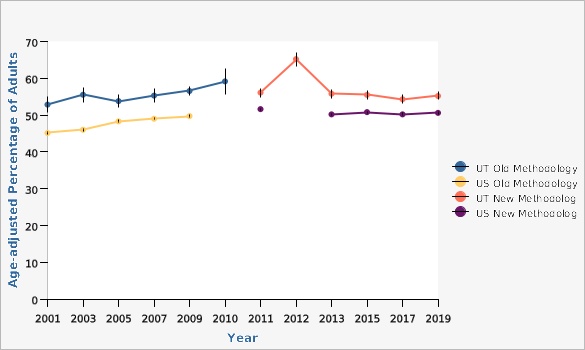PHOM Indicator Profile Report of Physical Activity: Recommended Aerobic Activity Among Adults
Why Is This Important?
Physical activity protects independently against cardiovascular disease. Physical activity has been shown to reduce the risk of some cancers, type 2 diabetes, stroke, and heart disease. Physical activity improves general physical and mental health. Regular physical activity helps to relieve pain from osteoarthritis. Regular physical activity is also known to improve effective disorders such as depression and anxiety, and increase quality of life and independent living among the elderly. Physical inactivity is a leading cause of premature death and also results in greater occurrence of illness.In 2019, Utah had a higher rate (55.2%) of meeting recommended amount of aerobic physical activity compared the U.S. rate (50.6%).
Physical activity questions are generally asked in odd years only. Utah added the questions for the 2012 BRFSS. Changes to the questionnaire in 2012 may have had an effect on the 2012 rate for Utah.
Data Sources
- The Utah Department of Health and Human Services Behavioral Risk Factor Surveillance System (BRFSS)
- Behavioral Risk Factor Surveillance System Survey Data, US Department of Health and Human Services Centers for Disease Control and Prevention (CDC).
Data Notes
In 2016, Utah BRFSS modified its methodology for age adjustment for increased precision. With this change Utah is consistent with both the U.S. and other states using IBIS. Data has been updated from 2011 onward in all chart views to reflect this change. In 2011, the BRFSS changed its methodology from a landline only sample and weighting based on post-stratification to a landline/cell phone sample and raking as the weighting methodology. Raking accounts for variables such as income, education, marital status, and home ownership during weighting and has the potential to more accurately reflect the population distribution. For more information about raking, see https://ibis.health.utah.gov/ibisph-view/pdf/opha/resource/brfss/RakingImpact2011.pdf Due to changes in both sampling and the wording of the questions in 2011, data for 2011 forward should not be compared to previous years. Age-adjusted to U.S. 2000 population.Risk Factors
The percentage of persons who reported getting the recommended amount of physical activity is lower among adults with lower levels of income and education.How Are We Doing?
The Healthy People 2020 (HP2020) U.S. target for recommended aerobic physical activity is 47.9%. This target has been reached both in Utah and nationwide. Using the identical age categories for the U.S. rate as used in HP2020, the age-adjusted rate for Utah was 55.2%.What Is Being Done?
The Utah Department of Health's, Healthy Environments Active Living program plays a key role in improving the health of residents in the state of Utah. The program was formed in July 2013 (as EPICC), through a new funding opportunity from the Centers of Disease Control and Prevention (CDC) that allowed for the merging of three previously existing programs: the Heart Disease and Stroke Prevention Program, the Diabetes Prevention and Control Program, and the Physical Activity, Nutrition and Obesity Program, as well as the addition of a school health program. The Healthy Environments Active Living Program was recently restructured as part of this strategic planning process and the new program model focuses on working together with staff and partners to address the social determinants of health while advancing health equity and increasing policy, systems and environment changes. HEAL works: In Schools:[[br]] 1) Schools are encouraged to adopt the Comprehensive School Physical Activity Program. This framework encourages students to be physically active for 60 minutes a day through school, home, and community activities.[[br]] 2) Height and weight trends are being tracked in a sample of elementary students to monitor Utah students.[[br]] 3) Action for Healthy Kids brings partners together to improve nutrition and physical activity environments in Utah's schools by implementing the school-based state plan strategies, working with local school boards to improve or develop policies for nutritious foods in schools. This includes recommendations for healthy vending options. In Worksites:[[br]] 1) The Utah Council for Worksite Health Promotion recognizes businesses that offer employee fitness and health promotion programs.[[br]] 2) HEAL offers a training on developing worksite wellness programs called Work@Health. HEAL also partners with local health departments to encourage worksites to complete the CDC Scorecard and participate in yearly health risk assessment for their employees. HEAL provides toolkits and other resources for employers interested in implementing wellness programs through the [http://heal.health.utah.gov heal.health.utah.gov] website: [https://heal.health.utah.gov/worksite-wellness/] In Communities:[[br]] 1) Local health departments (LHDs) receive federal funding to partner with schools, worksites, and other community based organizations to increase access to fresh fruits and vegetables through Eat Well Utah, farmers markets and retail stores. LHDs also work with cities within their jurisdictions to create a built environment that encourages physical activity. In Healthcare:[[br]] 1) HEAL works with health care systems to establish community clinical linkages to support individuals at risk for or diagnosed with diabetes or hypertension to engage in lifestyle change programs such as chronic disease self-management and diabetes prevention programs. In Childcare:[[br]] 1) Ten local health departments statewide have implemented the TOP Star program, which aims to improve the nutrition, physical activity, and breastfeeding environments and achieve best practice in child care centers and homes.[[br]] 2) HEAL works with state and local partners through the Childcare Obesity Prevention workgroup to implement policy and systems changes in early care and education across agencies statewide.Healthy People Objective: Increase the proportion of adults who engage in aerobic physical activity of at least moderate intensity for at least 150 minutes/week, or 75 minutes/week of vigorous intensity, or an equivalent combination
U.S. Target: 47.9 percentDate Indicator Content Last Updated: 10/29/2021
Other Views
- Utah and U.S. Adults Age 18+, 2001-2019
- by Gender and Age Group, Utah Adults Aged 18+ (Crude Rates), 2019
- by Ethnicity, Utah Adults Aged 18+, 2019
- by Race, Utah Adults Aged 18+, 2017 & 2019
- by Local Health District, Utah, 2019
- by Utah Small Area, Adults Aged 18+, 2017 & 2019
- by Income, Utah, 2019
- by Education, Utah Adults 25+, 2019

